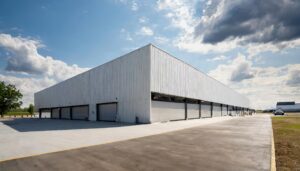- High Supply and Absorption: The Memphis industrial market has experienced a significant influx of new supply, with 9.8 million square feet (SF) delivered in the past 12 months and another 5.2 million SF under construction. Despite this increase, the market has shown strong absorption, with 5.9 million SF absorbed over the same period.
- Stable Vacancy Rates: The robust demand for industrial space in Memphis has kept vacancy rates relatively stable, indicating that the new development is meeting the needs of a healthy market rather than creating an oversupply.
- Rent Growth: Rental rates in Memphis have risen by 7.6% over the past year, reaching an average of $5.20/SF, significantly lower than the national average of $11.60/SF.
- Long-Term Market Stability: Although the short-term may experience an increase in vacancies due to new supply, a robust blue-collar workforce, strategic geographical location, and gradual population growth will likely stabilize Memphis’s industrial market in the long term.
- Future Demand Drivers: The upcoming Ford EV manufacturing facility, slated to open in 2025, is anticipated to boost industrial demand in the region further, attracting auto-related firms seeking proximity to the new plant.
Page Contents
- Supply and Demand Dynamics
- Infrastructure and Strategic Location
- Northern Mississippi’s Industrial Growth
- Historical Leasing Trends
- Long-Term Market Prospects
- Rising Rent Growth
- Navigating Speculative Supply
- Competitive Leasing Rates
- Market Stability Amid Growth
- Active Development in Memphis
- Speculative Supply Risks
- DeSoto County’s Construction Boom
- Memphis’s Industrial Market Evolution
- Investment Appeal Amidst Uncertainty
- Transaction Trends and Market Cautiousness
- Rising Cap Rates in Memphis
- Connecting Investment Dynamics
- Closing Thoughts
Supply and Demand Dynamics
 Memphis’s industrial market saw 9.8 million SF delivered recently, according to CoStar. Yet, absorption is slowing, with a notable decline.
Memphis’s industrial market saw 9.8 million SF delivered recently, according to CoStar. Yet, absorption is slowing, with a notable decline.Despite historical activity, leasing has fallen for four quarters. This trend hints at a market shift.
Memphis’s current industrial vacancy rate is 6.8%, higher than the national average. With 5.2 million SF under construction, supply pressures persist.
Infrastructure and Strategic Location
Memphis thrives on robust infrastructure, aiding its industrial market. Primary transport links bolster its status as a key distribution hub.
Home to the busiest cargo airport in the U.S., Memphis excels in logistics. The region’s extensive transport network, including Interstate 269 and the Port of Memphis, underpins its distribution strength. These assets facilitate quick southern and central U.S. access.
Northern Mississippi’s Industrial Growth
Northern Mississippi, especially DeSoto County, leads in new development. Significant leasing renewals and expansions mark this area’s growth.
Notable renewals in DeSoto include Milwaukee Electric Tool and Fiskars Brands. Barrett Distributors’ new presence in Marshall County underscores the area’s industrial appeal. These moves reflect the area’s draw for large industrial tenants.
Historical Leasing Trends
Memphis’s industrial sector has historically been vibrant, with substantial leasing each quarter. However, this has recently waned.
Once boasting over 5 million SF in leases quarterly, the trend is down. Last year’s peak leasing activity has since decreased, aligning with the general slowdown in net absorption, signaling a market recalibration.
Long-Term Market Prospects
While immediate challenges like vacancy risks exist, Memphis’s industrial sector shows resilience. Its strategic location and ongoing development projects are pivotal.
The future looks promising, anchored by infrastructure and location advantages. Despite current fluctuations, these factors suggest a stable long-term outlook for Memphis’s industrial market.
Rising Rent Growth
 Memphis sees strong rent growth at 7.6%, surpassing national averages, especially in flex spaces.
Memphis sees strong rent growth at 7.6%, surpassing national averages, especially in flex spaces.The city’s rent increase, notably in flex spaces, shows a unique market trend. This growth marks Memphis as a standout in the industrial sector. The local industrial market shines, with rent growth indicators looking promising.
Despite new speculative supply, Memphis’s vacancy rate remains under the 10-year average.
The incoming speculative projects test the market’s robustness. However, the low historical vacancy rate offers some cushion. As these spec spaces come to market, assessing their impact is crucial.
Competitive Leasing Rates
Memphis offers lower industrial rents than other major distribution hubs, making it an attractive market.
With asking rents significantly below the national and regional averages, Memphis stands out for affordability. This cost advantage positions Memphis favorably in the competitive landscape. Such affordability could entice more tenants to the area.
Market Stability Amid Growth
Memphis’s industrial sector balances rental growth and the manageable speculative supply.
This balance underscores a stable yet dynamic market environment. As Memphis grows, its industrial sector’s adaptability will be key. The market’s ability to sustain growth while offering competitive rates is significant.
Active Development in Memphis
Memphis’s industrial scene is bustling, with 9.8 million SF recently completed and more underway.
Noteworthy developments like Legacy Park and Memphis Oaks Logistics Center signify a growth spurt. The continuous construction activity keeps the market dynamic and evolving. These completions feed into Memphis’s reputation as a thriving industrial hub.
Speculative Supply Risks
With a robust pipeline, including 5.2 million SF in progress, speculative developments could affect market stability.
Unleased spec buildings, like Ford’s Blue Oval project, might influence vacancy and rent trends. The balance between development and market absorption is crucial. Monitoring these factors will be key in predicting the market’s direction.
DeSoto County’s Construction Boom
DeSoto County leads in construction within the Memphis metro, attracting companies with its strategic advantages.
As a construction hotspot, DeSoto County benefits from a skilled workforce and infrastructure upgrades. It’s a key player in the regional market with significant square footage completed and more in progress. The area’s focus on large distribution centers caters to evolving industrial needs.
Memphis’s Industrial Market Evolution
Significant development, speculative supply concerns, and DeSoto County’s prominence characterize the industrial market in Memphis.
These elements reflect a market in transition, facing both opportunities and challenges. As Memphis adapts to these dynamics, its industrial sector remains a critical economic driver. The region’s growth trajectory hinges on how these trends unfold.
Investment Appeal Amidst Uncertainty
Despite economic challenges, thanks to high cap rates and low acquisition costs, Memphis’s industrial sector remains attractive to investors.
With prices significantly below the national average, Memphis offers a cost-effective entry point. The slight premium for logistics properties reflects the area’s strategic importance. This pricing dynamic keeps Memphis attractive in a fluctuating market.
Transaction Trends and Market Cautiousness
Memphis witnessed 190 industrial transactions recently, yet investment is tapering off due to growing caution.
The total investment reached $456 million, illustrating a vibrant transaction landscape. However, the decreasing quarterly volumes signal a shift towards investor wariness. This trend indicates a more measured approach in the face of market volatility.
Rising Cap Rates in Memphis
The Memphis market sees cap rates around 8.2%, indicating a shift after a decade of generally declining rates.
This increase in cap rates suggests a changing investment climate in Memphis. After years of decline, this uptick reflects a recalibration in response to broader economic pressures. Investors reassessing their strategies are testing the market’s adaptability.
Connecting Investment Dynamics
The interplay of low prices, transaction trends, and shifting cap rates in Memphis’s industrial market paints a complex picture.
These factors shape the investment landscape, making Memphis a market of nuanced opportunities. Despite uncertainties, its core strengths maintain its appeal. How these dynamics evolve will be key to understanding the region’s investment future.
Closing Thoughts
In conclusion, Memphis’s industrial market shows dynamic growth, with strategic developments and attractive investment metrics. Despite challenges, its potential remains strong. For tailored investment solutions and deeper market insights, contact Lumicre. Let us guide you on your journey in the Memphis industrial sector.